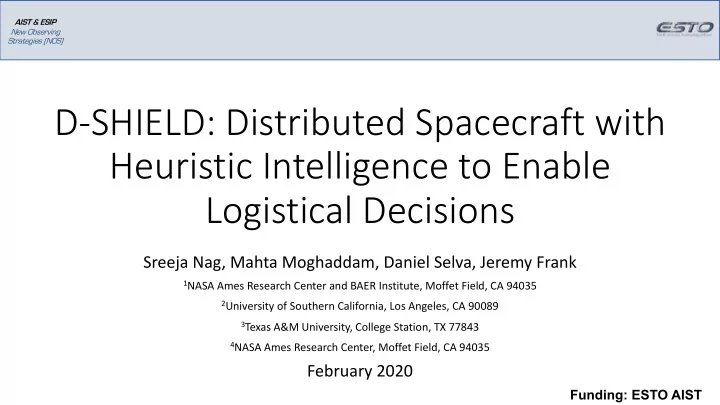

AIST & ESIP New Observing Strategies (NOS) D-SHIELD: Distributed Spacecraft with Heuristic Intelligence to Enable Logistical Decisions Sreeja Nag, Mahta Moghaddam, Daniel Selva, Jeremy Frank 1 NASA Ames Research Center and BAER Institute, Moffet Field, CA 94035 2 University of Southern California, Los Angeles, CA 90089 3 Texas A&M University, College Station, TX 77843 4 NASA Ames Research Center, Moffet Field, CA 94035 February 2020 Funding: ESTO AIST
D-SHIE SHIELD LD + So Soil Moisture e AIST & ESIP Monitoring g for Uncer certainty y Minimi mization New Observing Strategies (NOS) Product: Suite of scalable software tools that helps schedule payload operations of a large constellation, with multiple payloads per and across spacecraft, such that the collection of observational data and their downlink, results in maximum science value for a selected use case S. Nag, M. Moghaddam, D. Selva, J. Frank, “D-SHIELD", IEEE International Geoscience and Remote Sensing Symposium, Hawaii, July 2020
AIST & ESIP Pr Project Technologies New Observing Strategies (NOS) Received Bundles (S, Ω , GP, і ) Comm specs (C), Satellite ACS Ground Points (GP), Protocol ( ѕ ), characteristics (X) Field of Regard (FOR), Contact Plan + GP, S Current Sat States (S) ( Ǩ =f(S)) Orbital Attitude Communication Mechanics Control Bundle delivery Power, Slewing Basic modules Bundle Prev latency (L) per times per satellite Access times (A) Data bundle traffic + Payload module GPs satellite pair, per ( Ĵ ), Satellite-Ground per satellite, GP, priority (BP), generated seen observed GP + Ground Module pairs (s-gp i ,s-gp j ) off-nadir angle Inter-sat distances (N) + Power/Data Scheduling Optimization module (Dynamic Programming, validated with Mixed Integer Programming) Value і + New Science Bundle Broadcast per GP, Schedule of pointing commands Simulator ( і , GP, Ω , S) Spatial Ћ , Temporal Ћ ( Ω =path sat [gp i ,t i ] ) + New Scheduler
Agi gile e Sp Spacecr cecraft Constel ellations s Maximi mizi zing g AIST & ESIP New Observing Cover Co erage e and Revisit Strategies (NOS) § Small Sat constellation + Full-body reorientation agility + Ground scheduling autonomy = More Coverage, for any given number of satellites in any given orbits § Using Landsat as first case study (710 km, SSO, 15 deg FOV) w/ a 14 day revisit. Daily revisit needs ~15 satellites or 4 satellites with triple the FOV. § Assuming a 20 kg satellite platform for option of agile pointing § Scheduling algorithm allows 2 sat constellation over 12 hours to observe 2.5x compared to the fixed pointing approach. 1.5x with a 4-sat constellation § Extendable to monitoring applications (e.g. coral reefs) S. Nag, A.S. Li, J.H. Merrick, "Scheduling Algorithms for Rapid Imaging using Agile Cubesat Constellations", COSPAR Advances in Space Research - Astrodynamics 61, Issue 3 (2018), 891-913 4
Agi gile e Sp Spacecr cecraft Constel ellations s Maximi mizi zing g AIST & ESIP New Observing Co Cover erage e and Revisit Strategies (NOS) Over 12 hours of planning horizon using 2 satellites, 180 deg apart in the same plane : • Using a fixed Landsat sensor , as is • Using our proposed DP algorithm Adding onboard autonomy to flight software + inter-sat communication to the constellation 5 can improve science-driven responsiveness?
Agi gile e Sp Spacecr cecraft Constel ellations s with AIST & ESIP Del elay y Toler erant Networki king g for Rea eact ctive e Monitoring New Observing Strategies (NOS) S. Nag, A. S. Li, V. Ravindra, M. Sanchez Net, K.M. If longest latency < shortest gap, for pairs with the same priority Cheung, R. Lammers, B. Bledsoe, "Autonomous => each satellite can be considered fully updated with Scheduling of Agile Spacecraft Constellations with Delay Tolerant Networking for Reactive Imaging", International information from all others, i.e. perfect consensus is possible, in Conference on Automated Planning and Scheduling spite of distributed decisions made on a disjoint graph. 6 SPARK Workshop, Berkeley CA, July 2019
In Initial Tool applied ed to Episo sodic c Preci ecipitation AIST & ESIP New Observing an and Tran ansie sient Flood loods Strategies (NOS) Value Function Snapshot Appropriately low latency in information exchange enables the onboard scheduler to observe ~7% more flood magnitude than a ground-based implementation. Both onboard and offline versions performed ~98% better than constellations without agility. 7
AIST & ESIP New Observing Strategies (NOS) Questions? Sreeja.Nag@nasa.gov SreejaNag@alum.mit.edu 8
Project Relation to NOS Concept AIST & ESIP New Observing Strategies (NOS) • Brief description of where your project fits into a NOS concept. For example but not limited to: • onboard data understanding and analysis; • inter-node coordination (including comms, standards, ontologies, commands); • Planning, scheduling and decision making; • Interaction to science and forecast models; • Cybersecurity • Include graphics or pictures if appropriate.
Recommend
More recommend